A Recursive Conic Approximation for Solving the Optimal Power Flow Problem in Bipolar Direct Current Grids
Abstract
1. Introduction
- i.
- A convex approximation for the power balance constraint associated with constant power loads using a conic representation of the hyperbolic relation between voltages and currents, and a linear approximation for nodes with dispersed generation sources.
- ii.
- An iterative convex solution methodology to minimize the error introduced by the linear approximation of the hyperbolic relation between voltage and currents in the dispersed generation sources via recursive convex programming.
2. Optimal Power Flow Modeling
2.1. Objective Function Formulation
2.2. Model Constraints
- i.
- If neutral wire is assumed to be floating, then the variable must be set as zero for all the nodes.
- ii.
- If the neutral wire is assumed to be solidly grounded at all nodes of the network, then is left as a free variable, and the voltage variable regarding the neutral pole (i.e., ) must be set as zero for all nodes of the network.
2.3. Model Interpretation
3. Iterative Conic Solution Approach
3.1. A Conic Approximation for Constant Power Loads
3.2. A Linear Approximation for Generation Sources
3.3. Approximate Convex Model and Iterative Conic Solution
4. Test Feeder Characteristics
4.1. Bipolar DC Configuration
4.2. Branch and Loading Information
4.3. Dispersed Generation Data
5. Computational Results
- i.
- A comparative analysis with three different power flow algorithms, two of them derivative-free and another one based on Taylor series expansion.
- ii.
- A comparison between the solution of the OPF problem with three combinatorial optimization methods and the proposed ICS approach.
5.1. Power Flow Solution
- i.
- The derivative-free power flow approaches (i.e., SAPF and SAPF methods) require the same number of iterations in each simulation case. This implies that these methods are numerically equivalent for power flow studies with linear convergence. The HAPF approach for the solidly grounded case exhibited a linear convergence with the same number of iterations as the SAPF and SAPF methods; and in the case of the floating neutral wire, the convergence was quadratic, requiring four iterations, in contrast with the ten iterations taken by the SAPF and SAPF methods.
- ii.
- The main difference regarding the connections of the neutral wire (i.e., the solidly grounded and the floating cases) was the total grid power loss. As expected, with the floating neutral wire, the losses value was kW, which was reduced to kW. i.e., a variation of about kW in favor of the solidly grounded connection. This is an expected behavior, as the current in the neutral wire is directly drained to the earth when it is solidly grounded, which helps to reduce power losses, in contrast with the neutral floating wire, where the presence of asymmetric loads produces neutral circulating currents.
- iii.
- As for processing times, the ICS takes about 5 s to solve the power flow problem, which is a higher value in comparison with the specialized power flow methods, in which only milliseconds are spent. However, it is worth highlighting that the ICS for model (34) involves an optimization problem with infinite feasible solutions and only one global optimal solution. In contrast, the specialized power flow methods can solve the problem without employing combinatorial optimization approach in a master–slave connection.
5.2. OPF Solution
- i.
- The best combinatorial optimization method is the VSA, as demonstrated in [34]. This algorithm found a solution of kW, which is near the optimal solution reached with the ICS ( kW). The main difference between both approaches lies in their standard deviation: the VSA reported about , whereas that of the proposed ICS was less than . These values confirm two things. (i) It is impossible to ensure 100% repeatability with the VSA approach, since the standard deviation is a measure associated with the dispersion between solutions. Even if these are in a closed ball, it is possible to obtain an answer out of it, as is the case of the maximum solution ( kW). (ii) Due to the convex nature of the solution space in model (34), the proposed ICS always reaches the exact numerical solution, thereby confirming the standard deviation’s negligible value.
- ii.
- The BHO and SCA got stuck in locally optimal solutions, with values of and kW. However, these solutions can be regarded as acceptable for the power flow solution, since both were less than 0.10 kW away from the optimal one (i.e., solution found with the ICS). Nevertheless, the main problem with these solutions lies in the high variability between their minimum and maximum values, which can be observed in their standard deviation.
- iii.
- Concerning the processing times, it is noted that all of the OPF algorithms in Table 4 required simulation times of between 8 and 13.5 s. However, each one of the combinatorial optimizers requires multiple evaluations in order to determine their average behavior, which means that, after 100 consecutive evaluations, the processing times of the ICS were effectively 100 times higher. This implies that the proposed methodology is the most effective approach, given the fact that no statistical analysis is needed.
5.3. Complementary Analysis
- i
- The minimum voltage in the benchmark case (without dispersed generation) occurred at the positive pole, i.e., a value of pu at node 17, which implies that the voltage regulation of the bipolar DC network was about . This is a significant result, as it demonstrates that, without dispersed generation, the 21-bus network does not fulfill the voltage regulation condition for distribution networks (typically ). However, this only occurs for the positive pole because it is the most loaded pole. In the case of the negative pole, the minimum voltage was , which implies that the voltage regulation for this pole is below the permitted limits.
- ii.
- The behavior of the neutral pole shows that, once the dispersed generation is introduced into the distribution network, it helps balance the voltage behavior of the systems. Note that the maximum voltage in the neutral wire was pu, i.e., 24.34 V at node 17 in the benchmark case. In contrast, when the dispersed generation was optimally dispatched, the maximum voltage deviation in the neutral wire was about pu, i.e., 13.90 V at node 12.
- iii.
- The presence of dispersed generation in bipolar DC networks has important effects on the performance of the voltage profile. Note that node 17, for the positive and negative poles, has a magnitude of 1.0 pu, i.e., an ideal voltage profile due to the injection of power at this node with the dispersed sources. In addition, the voltage regulation for this system with dispersed sources was . The minimum voltage at node 12 had a magnitude of in the negative pole.
6. Conclusions and Future Work
- i.
- The proposed ICS reached an equal solution for the power flow problem when compared to three different specialized power flow approaches (SAPF, TBPF, and HAPF) for both simulation cases associated with the neutral wire’s connection, i.e., the solidly grounded and floating cases.
- ii.
- The OPF solution showed that the ICS found the global optimal solution for the 21-bus grid, with a value of kW. The VSA approach, with a near-optimal solution, only followed the ICS. However, the proposed method always reached an equal optimal solution due to the convex nature of the solution space. In contrast, the VSA and the other comparison methods (BHO and SCA) can get stuck in locally optimal solutions, as evidenced by the statistical analysis.
- iii.
- The voltage profile analysis showed that, for the benchmark case, when the neutral wire is floating, the voltage regulation in the test feeder is about . However, when the dispersed generation is optimally dispatched, the voltage regulation of the 21-bus grid is improved, with a final value of . This implies that dispersed generators allow for an improvement of about .
Author Contributions
Funding
Institutional Review Board Statement
Informed Consent Statement
Data Availability Statement
Acknowledgments
Conflicts of Interest
References
- Mackay, L.; Dimou, A.; Guarnotta, R.; Morales-Espania, G.; Ramirez-Elizondo, L.; Bauer, P. Optimal power flow in bipolar DC distribution grids with asymmetric loading. In Proceedings of the 2016 IEEE International Energy Conference (ENERGYCON), Leuven, Belgium, 4–8 April 2016; IEEE: Piscataway, NJ, USA, 2016. [Google Scholar] [CrossRef]
- Monteiro, V.; Monteiro, L.F.C.; Franco, F.L.; Mandrioli, R.; Ricco, M.; Grandi, G.; Afonso, J.L. The Role of Front-End AC/DC Converters in Hybrid AC/DC Smart Homes: Analysis and Experimental Validation. Electronics 2021, 10, 2601. [Google Scholar] [CrossRef]
- Rivera, S.; F., R.L.; Kouro, S.; Dragicevic, T.; Wu, B. Bipolar DC Power Conversion: State-of-the-Art and Emerging Technologies. IEEE J. Emerg. Sel. Top. Power Electron. 2021, 9, 1192–1204. [Google Scholar] [CrossRef]
- Tan, L.; Zhu, N.; Wu, B. An Integrated Inductor for Eliminating Circulating Current of Parallel Three-Level DC–DC Converter-Based EV Fast Charger. IEEE Trans. Ind. Electron. 2016, 63, 1362–1371. [Google Scholar] [CrossRef]
- Doubabi, H.; Salhi, I.; Essounbouli, N. A Novel Control Technique for Voltage Balancing in Bipolar DC Microgrids. Energies 2022, 15, 3368. [Google Scholar] [CrossRef]
- Rivera, S.; Wu, B.; Wang, J.; Athab, H.; Kouro, S. Electric vehicle charging station using a neutral point clamped converter with bipolar DC bus and voltage balancing circuit. In Proceedings of the IECON 2013-39th Annual Conference of the IEEE Industrial Electronics Society, Vienna, Austria, 10–13 November 2013; IEEE: Piscataway, NJ, USA, 2013. [Google Scholar] [CrossRef]
- Guo, C.; Wang, Y.; Liao, J. Coordinated Control of Voltage Balancers for the Regulation of Unbalanced Voltage in a Multi-Node Bipolar DC Distribution Network. Electronics 2022, 11, 166. [Google Scholar] [CrossRef]
- Yang, M.; Zhang, R.; Zhou, N.; Wang, Q. Unbalanced voltage control of bipolar DC microgrid based on distributed cooperative control. In Proceedings of the 2020 15th IEEE Conference on Industrial Electronics and Applications (ICIEA), Kristiansand, Norway, 9–13 November 2020; IEEE: Piscataway, NJ, USA, 2020. [Google Scholar] [CrossRef]
- Monteiro, V.; Oliveira, C.; Coelho, S.; Afonso, J.L. Hybrid AC/DC Electrical Power Grids in Active Buildings: A Power Electronics Perspective. In Active Building Energy Systems; Springer International Publishing: Berlin/Heidelberg, Germany, 2022; pp. 71–97. [Google Scholar] [CrossRef]
- Li, J.; Liu, F.; Wang, Z.; Low, S.H.; Mei, S. Optimal Power Flow in Stand-Alone DC Microgrids. IEEE Trans. Power Syst. 2018, 33, 5496–5506. [Google Scholar] [CrossRef]
- Kim, H.J.; Lee, Y.S.; Lee, J.G.; Han, B.M. Operation analysis of bipolar DC distribution system with voltage balancer. In Proceedings of the 2014 Australasian Universities Power Engineering Conference (AUPEC), Perth, WA, Australia, 28 September–1 October 2014; IEEE: Piscataway, NJ, USA, 2014. [Google Scholar] [CrossRef]
- Lee, J.O.; Kim, Y.S.; Jeon, J.H. Optimal power flow for bipolar DC microgrids. Int. J. Electr. Power Energy Syst. 2022, 142, 108375. [Google Scholar] [CrossRef]
- Chew, B.S.H.; Xu, Y.; Wu, Q. Voltage Balancing for Bipolar DC Distribution Grids: A Power Flow Based Binary Integer Multi-Objective Optimization Approach. IEEE Trans. Power Syst. 2019, 34, 28–39. [Google Scholar] [CrossRef]
- Montoya, O.D.; Gil-González, W.; Garcés, A. A successive approximations method for power flow analysis in bipolar DC networks with asymmetric constant power terminals. Electr. Power Syst. Res. 2022, 211, 108264. [Google Scholar] [CrossRef]
- Mackay, L.; Guarnotta, R.; Dimou, A.; Morales-Espana, G.; Ramirez-Elizondo, L.; Bauer, P. Optimal Power Flow for Unbalanced Bipolar DC Distribution Grids. IEEE Access 2018, 6, 5199–5207. [Google Scholar] [CrossRef]
- Medina-Quesada, Á.; Montoya, O.D.; Hernández, J.C. Derivative-Free Power Flow Solution for Bipolar DC Networks with Multiple Constant Power Terminals. Sensors 2022, 22, 2914. [Google Scholar] [CrossRef]
- Marini, A.; Mortazavi, S.; Piegari, L.; Ghazizadeh, M.S. An efficient graph-based power flow algorithm for electrical distribution systems with a comprehensive modeling of distributed generations. Electr. Power Syst. Res. 2019, 170, 229–243. [Google Scholar] [CrossRef]
- Kim, J.; Cho, J.; Kim, H.; Cho, Y.; Lee, H. Power Flow Calculation Method of DC Distribution Network for Actual Power System. KEPCO J. Electr. Power Energy 2020, 6, 419–425. [Google Scholar] [CrossRef]
- Sepúlveda-García, S.; Montoya, O.D.; Garcés, A. Power Flow Solution in Bipolar DC Networks Considering a Neutral Wire and Unbalanced Loads: A Hyperbolic Approximation. Algorithms 2022, 15, 341. [Google Scholar] [CrossRef]
- Garces, A.; Montoya, O.D.; Gil-Gonzalez, W. Power Flow in Bipolar DC Distribution Networks Considering Current Limits. IEEE Trans. Power Syst. 2022, 37, 4098–4101. [Google Scholar] [CrossRef]
- Lee, J.O.; Kim, Y.S.; Jeon, J.H. Generic power flow algorithm for bipolar DC microgrids based on Newton–Raphson method. Int. J. Electr. Power Energy Syst. 2022, 142, 108357. [Google Scholar] [CrossRef]
- Liao, J.; Zhou, N.; Wang, Q.; Chi, Y. Load-Switching Strategy for Voltage Balancing of Bipolar DC Distribution Networks Based on Optimal Automatic Commutation Algorithm. IEEE Trans. Smart Grid 2021, 12, 2966–2979. [Google Scholar] [CrossRef]
- Montoya, O.D.; Gil-González, W.; Hernández, J.C. Optimal Power Flow Solution for Bipolar DC Networks Using a Recursive Quadratic Approximation. Energies 2023, 16, 589. [Google Scholar] [CrossRef]
- Balamurugan, K.; Srinivasan, D. Review of power flow studies on distribution network with distributed generation. In Proceedings of the 2011 IEEE Ninth International Conference on Power Electronics and Drive Systems, Singapore, 5–8 December 2011; IEEE: Piscataway, NJ, USA, 2011. [Google Scholar] [CrossRef]
- Yu, D.; Cao, J.; Li, X. Review of power system linearization methods and a decoupled linear equivalent power flow model. In Proceedings of the 2018 International Conference on Electronics Technology (ICET), Chengdu, China, 23–27 May 2018; IEEE: Piscataway, NJ, USA, 2018. [Google Scholar] [CrossRef]
- Smon, I.; Verbic, G.; Gubina, F. Local Voltage-Stability Index Using Tellegen’s Theorem. IEEE Trans. Power Syst. 2006, 21, 1267–1275. [Google Scholar] [CrossRef]
- Garces, A. Uniqueness of the power flow solutions in low voltage direct current grids. Electr. Power Syst. Res. 2017, 151, 149–153. [Google Scholar] [CrossRef]
- Zohrizadeh, F.; Josz, C.; Jin, M.; Madani, R.; Lavaei, J.; Sojoudi, S. A survey on conic relaxations of optimal power flow problem. Eur. J. Oper. Res. 2020, 287, 391–409. [Google Scholar] [CrossRef]
- Farivar, M.; Low, S.H. Branch Flow Model: Relaxations and Convexification—Part I. IEEE Trans. Power Syst. 2013, 28, 2554–2564. [Google Scholar] [CrossRef]
- Garces, A. A Linear Three-Phase Load Flow for Power Distribution Systems. IEEE Trans. Power Syst. 2016, 31, 827–828. [Google Scholar] [CrossRef]
- Garces, A. On the Convergence of Newton’s Method in Power Flow Studies for DC Microgrids. IEEE Trans. Power Syst. 2018, 33, 5770–5777. [Google Scholar] [CrossRef]
- Kumar, S.; Datta, D.; Singh, S.K. Black Hole Algorithm and Its Applications. In Studies in Computational Intelligence; Springer International Publishing: Berlin/Heidelberg, Germany, 2014; pp. 147–170. [Google Scholar] [CrossRef]
- Brajević, I.; Stanimirović, P.S.; Li, S.; Cao, X.; Khan, A.T.; Kazakovtsev, L.A. Hybrid Sine Cosine Algorithm for Solving Engineering Optimization Problems. Mathematics 2022, 10, 4555. [Google Scholar] [CrossRef]
- Doğan, B.; Ölmez, T. Vortex search algorithm for the analog active filter component selection problem. AEU-Int. J. Electron. Commun. 2015, 69, 1243–1253. [Google Scholar] [CrossRef]
- Battarra, M.; Benedettini, S.; Roli, A. Leveraging saving-based algorithms by master–slave genetic algorithms. Eng. Appl. Artif. Intell. 2011, 24, 555–566. [Google Scholar] [CrossRef]
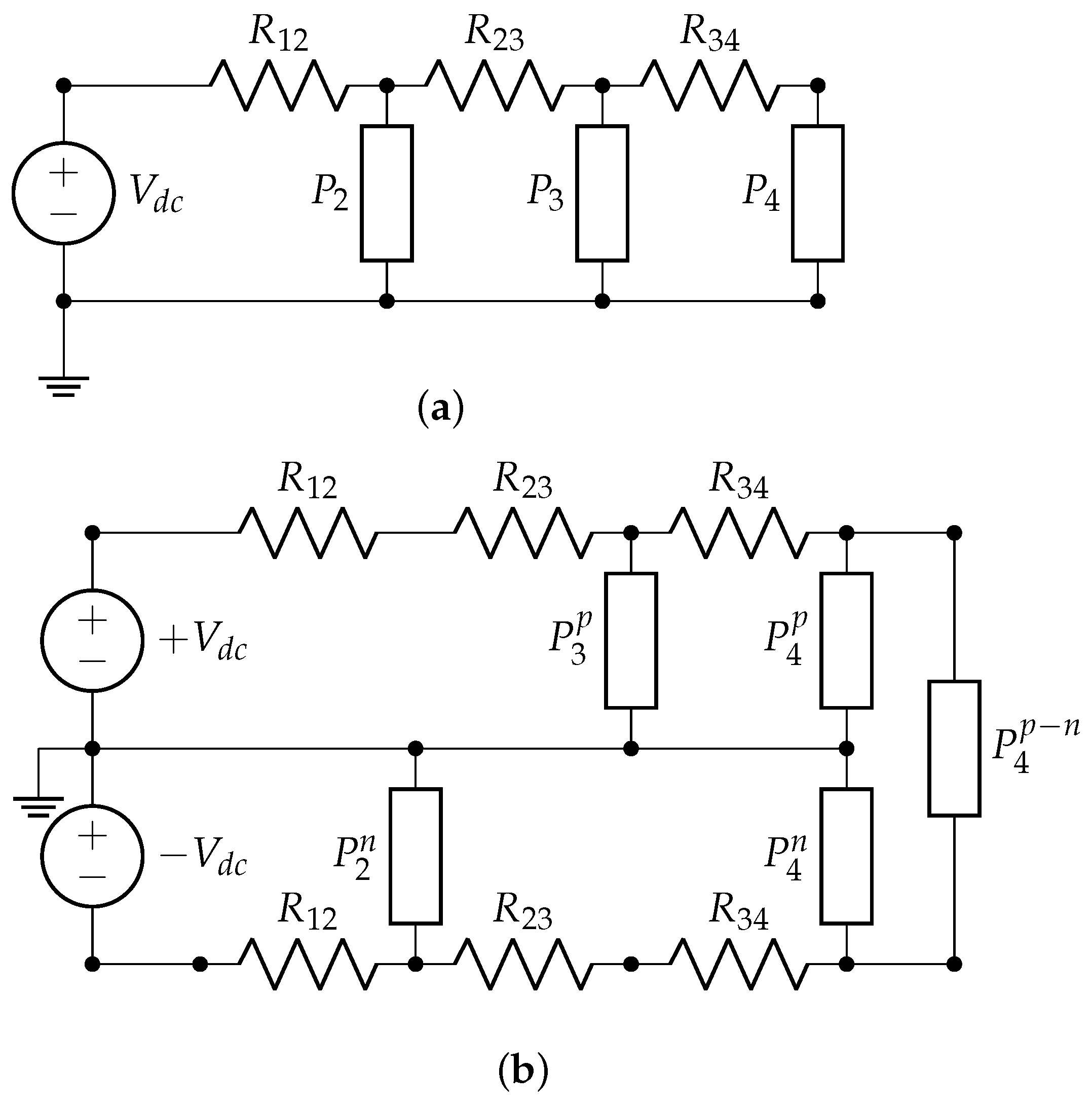
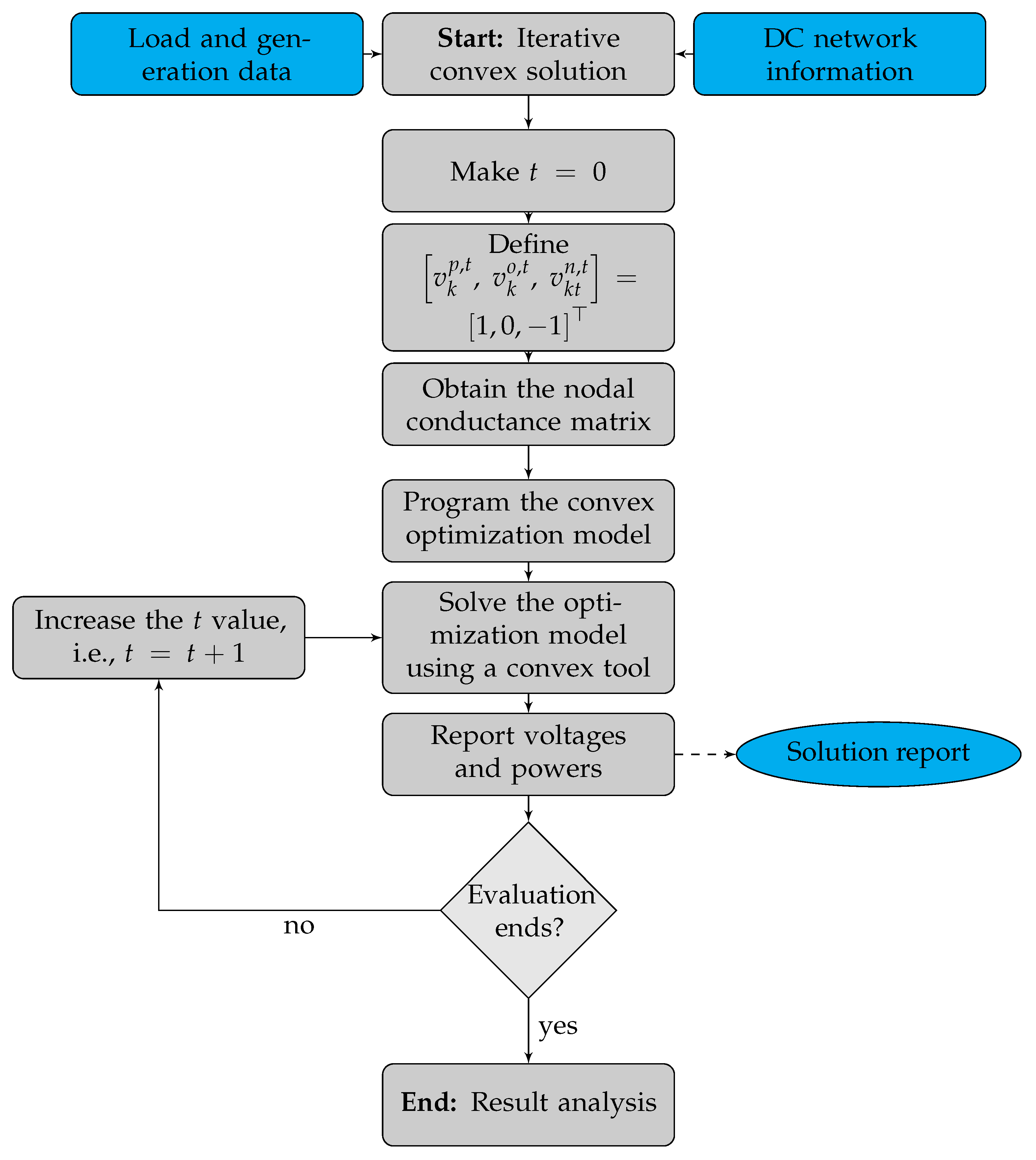
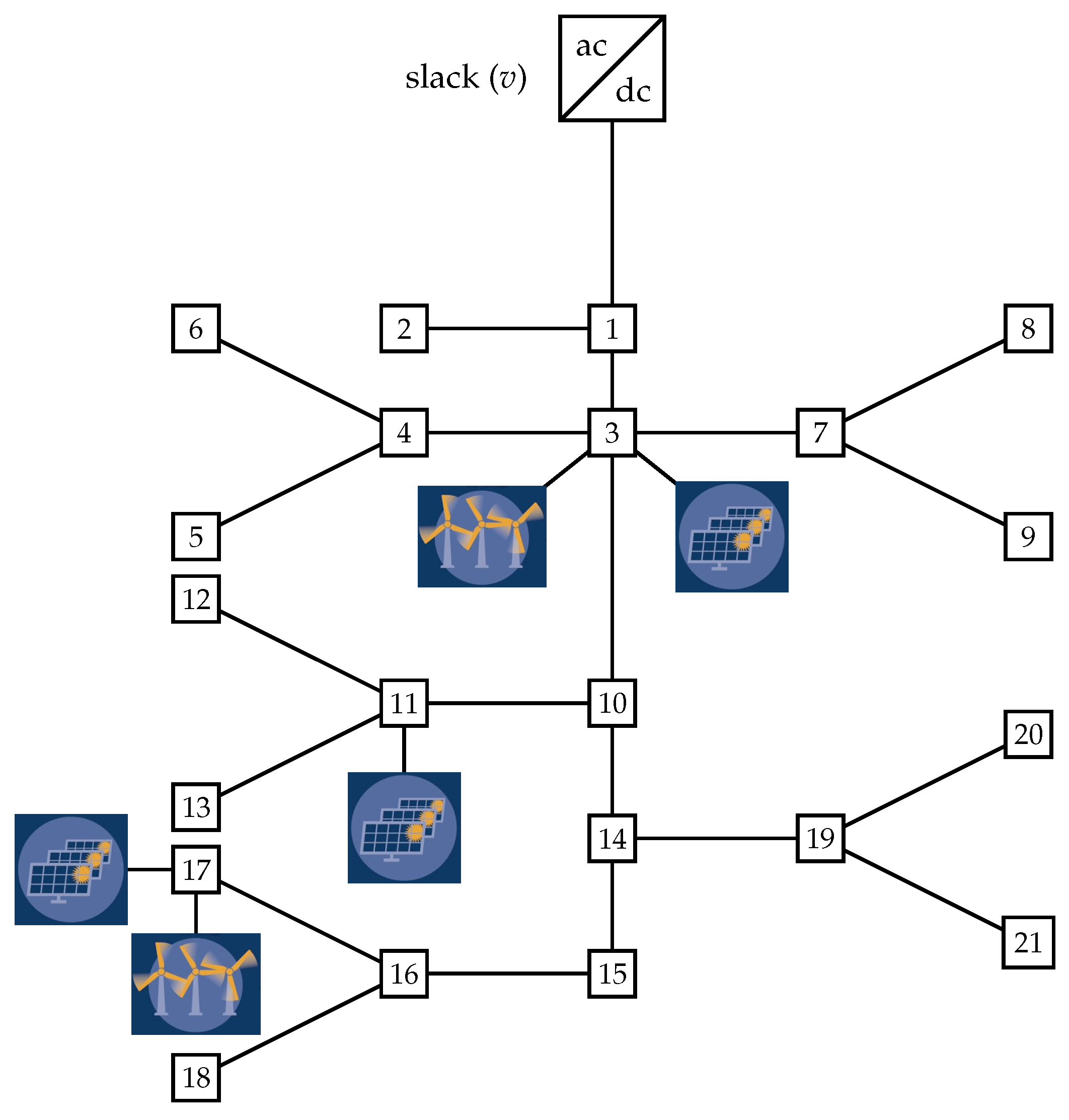
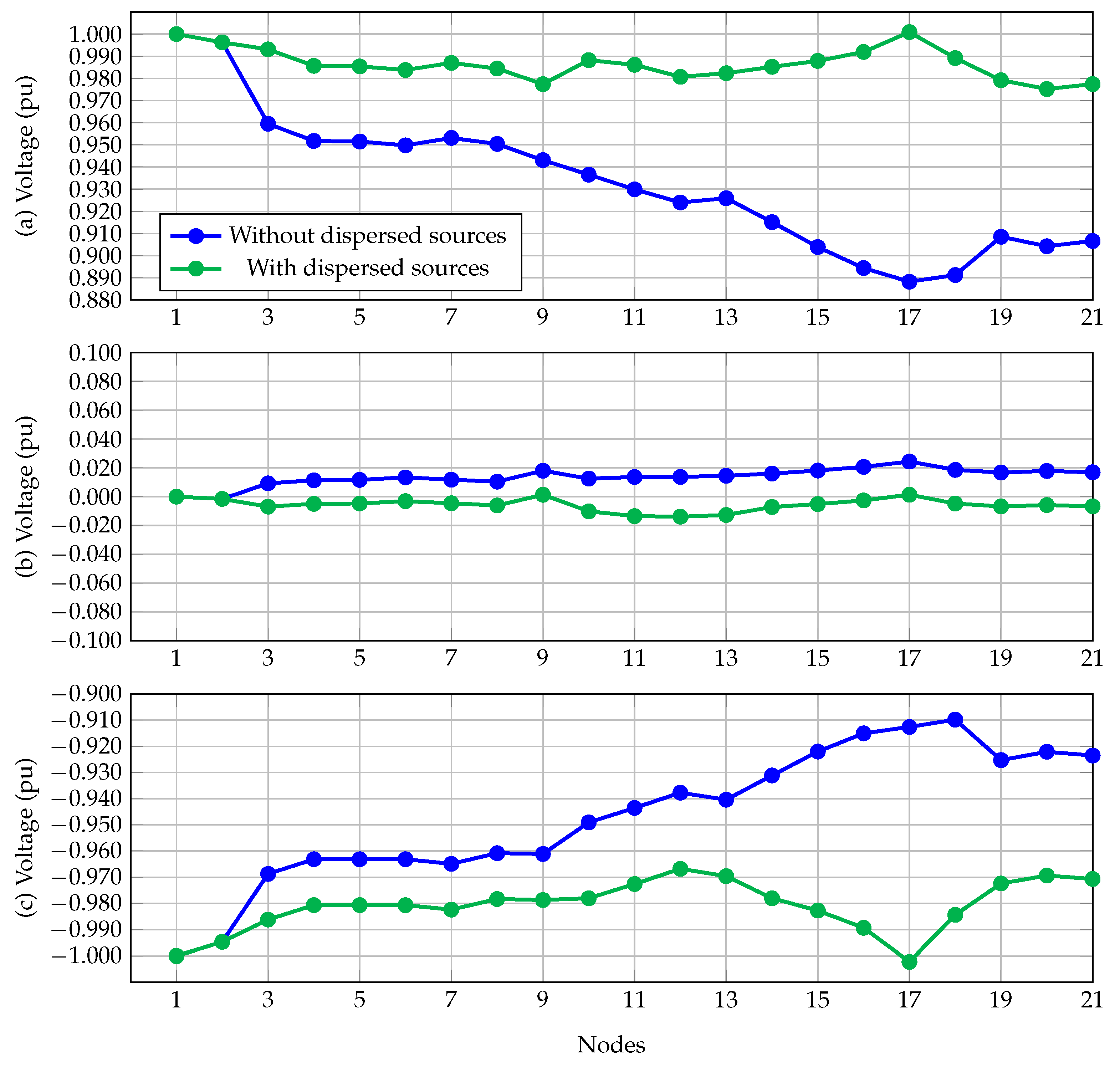
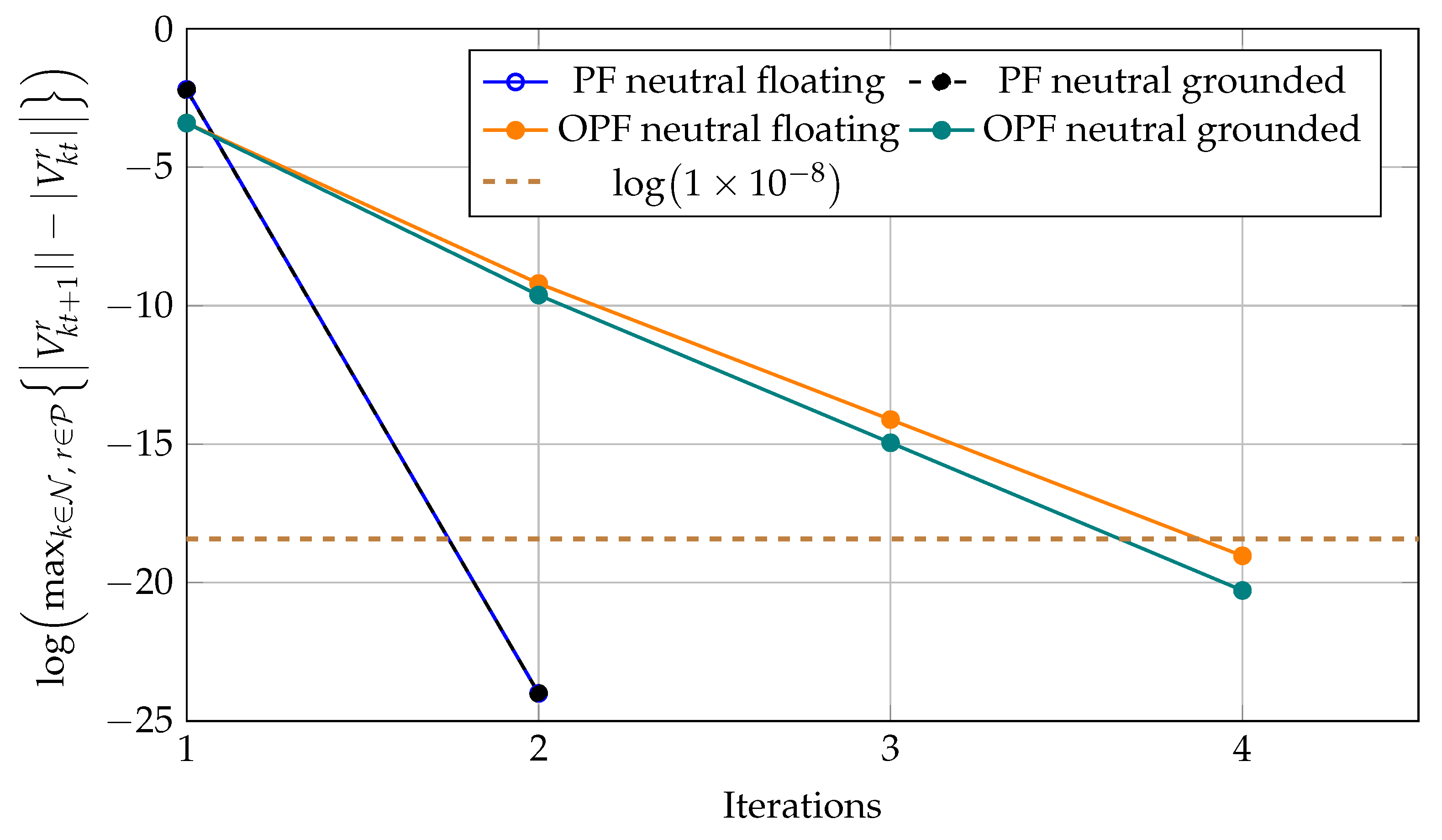
| Node j | Node k | () | |||
|---|---|---|---|---|---|
| 1 | 2 | 0.053 | 70 | 100 | 0 |
| 1 | 3 | 0.054 | 0 | 0 | 0 |
| 3 | 4 | 0.054 | 36 | 40 | 120 |
| 4 | 5 | 0.063 | 4 | 0 | 0 |
| 4 | 6 | 0.051 | 36 | 0 | 0 |
| 3 | 7 | 0.037 | 0 | 0 | 0 |
| 7 | 8 | 0.079 | 32 | 50 | 0 |
| 7 | 9 | 0.072 | 80 | 0 | 100 |
| 3 | 10 | 0.053 | 0 | 10 | 0 |
| 10 | 11 | 0.038 | 45 | 30 | 0 |
| 11 | 12 | 0.079 | 68 | 70 | 0 |
| 11 | 13 | 0.078 | 10 | 0 | 75 |
| 10 | 14 | 0.083 | 0 | 0 | 0 |
| 14 | 15 | 0.065 | 22 | 30 | 0 |
| 15 | 16 | 0.064 | 23 | 10 | 0 |
| 16 | 17 | 0.074 | 43 | 0 | 60 |
| 16 | 18 | 0.081 | 34 | 60 | 0 |
| 14 | 19 | 0.078 | 9 | 15 | 0 |
| 19 | 20 | 0.084 | 21 | 10 | 50 |
| 19 | 21 | 0.082 | 21 | 20 | 0 |
| Node | Connection | Capacity (kW) |
|---|---|---|
| 3 | p | 300 |
| 3 | n | 100 |
| 11 | p | 400 |
| 17 | p | 200 |
| 17 | n | 300 |
| Neutral Wire Solidly Grounded | |||
|---|---|---|---|
| Method | Losses (pu) | Iterations | Time (ms) |
| SAPF | 0.954237 | 13 | 0.5275 |
| TBPF | 0.954237 | 13 | 0.8340 |
| HAPF | 0.954237 | 13 | 1.5542 |
| ICS | 0.954237 | 2 | — |
| Neutral Wire Floating | |||
| Method | Losses (pu) | Iterations | Time (ms) |
| SAPF | 0.912701 | 10 | 0.4911 |
| TBPF | 0.912701 | 10 | 0.7672 |
| HAPF | 0.912701 | 4 | 1.0212 |
| ICS | 0.912701 | 2 | — |
| Method | Ref. | Evaluations | Iterations | Pop. Size |
|---|---|---|---|---|
| Black-hole optimizer (BHO) | [32] | |||
| Sine-cosine algorithm (SCA) | [33] | 100 | 1000 | 20 |
| Vortex-search algorithm (VSA) | [34] |
| Method | Min. | Mean | Max. | Std. Dev. | Time (s) |
|---|---|---|---|---|---|
| SCA | 0.23054 | 0.25305 | 0.29703 | 6.7870 | |
| BHO | 0.23066 | 0.23183 | 0.23329 | 13.1513 | |
| VSA | 0.22986 | 0.22986 | 0.22988 | 8.3176 | |
| ICS | 0.22985 | 0.22985 | 0.22985 | < | 11.6125 |
Disclaimer/Publisher’s Note: The statements, opinions and data contained in all publications are solely those of the individual author(s) and contributor(s) and not of MDPI and/or the editor(s). MDPI and/or the editor(s) disclaim responsibility for any injury to people or property resulting from any ideas, methods, instructions or products referred to in the content. |
© 2023 by the authors. Licensee MDPI, Basel, Switzerland. This article is an open access article distributed under the terms and conditions of the Creative Commons Attribution (CC BY) license (https://creativecommons.org/licenses/by/4.0/).
Share and Cite
Montoya, O.D.; Grisales-Noreña, L.F.; Hernández, J.C. A Recursive Conic Approximation for Solving the Optimal Power Flow Problem in Bipolar Direct Current Grids. Energies 2023, 16, 1729. https://doi.org/10.3390/en16041729
Montoya OD, Grisales-Noreña LF, Hernández JC. A Recursive Conic Approximation for Solving the Optimal Power Flow Problem in Bipolar Direct Current Grids. Energies. 2023; 16(4):1729. https://doi.org/10.3390/en16041729
Chicago/Turabian StyleMontoya, Oscar Danilo, Luis Fernando Grisales-Noreña, and Jesús C. Hernández. 2023. "A Recursive Conic Approximation for Solving the Optimal Power Flow Problem in Bipolar Direct Current Grids" Energies 16, no. 4: 1729. https://doi.org/10.3390/en16041729
APA StyleMontoya, O. D., Grisales-Noreña, L. F., & Hernández, J. C. (2023). A Recursive Conic Approximation for Solving the Optimal Power Flow Problem in Bipolar Direct Current Grids. Energies, 16(4), 1729. https://doi.org/10.3390/en16041729












